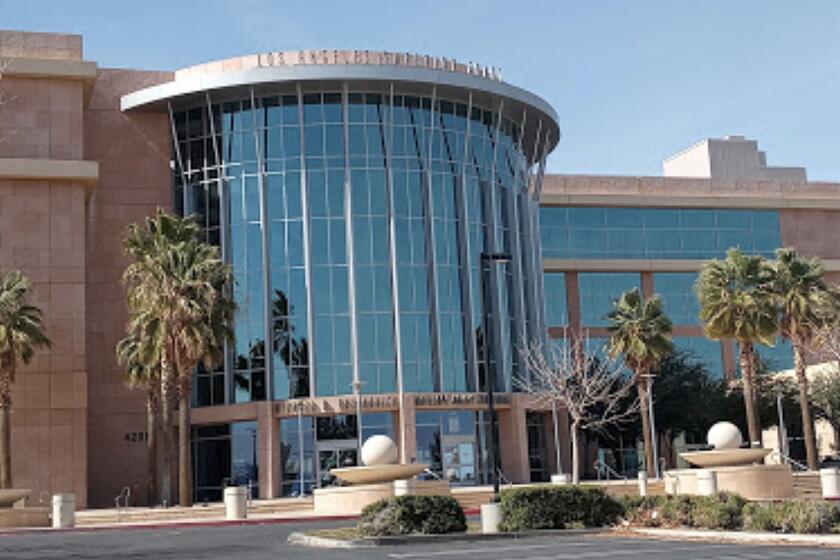La Habra
- Share via
LA HABRA — During the week, Mark Handler scans the streets and alleys for the graffiti he hates so much and takes mental notes.
Then, at 7 a.m. every Saturday and Sunday, the 39-year-old architect arms himself with paint brushes and rollers and sets off to attack graffiti all over town.
“I used to complain about the gang problem and the graffiti problem,” Handler said. “Then I realized I could help get things turned around. I stopped asking why it wasn’t being done and started doing it.”
Handler’s crusade is just one aspect of a campaign by both individuals and the city to revitalize La Habra, a 72-year-old unassuming city of 55,000 on the northern tip of Orange County.
“There’s a reborn interest here,” said local historian Esther Cramer, 69, a La Habra native. “People are feeling that we need to do something to [revive] the community.”
Just five years ago, the city was plagued by gang violence, vandalism and a sluggish economy that was driving businesses away and slowly deteriorating residents’ pride in their hometown.
“The town was slipping away from us,” Cramer said.
Today, city officials and residents agree, the situation is turning around, thanks to a rebounding economy, successful law enforcement programs and aggressive community activism.
The cornerstone of the effort is a redevelopment plan for La Habra Boulevard and Imperial Highway, the town’s main streets once considered downtown.
The old Fashion Square shopping center at Idaho Street and Imperial, for example, is getting a massive face-lift. The Bullock’s Department Store, which once anchored Fashion Square and stood empty for years, was demolished in 1995, and a number of new stores and restaurants are taking over the center, renamed La Habra MarketPlace.
Across the street, a run-down drive-in theater was replaced by a Super Kmart in 1994.
Last year, the City Council approved a plan to redevelop about 180 acres of blighted commercial and industrial properties. The plan helps owners finance improvements to the properties, which include shops and a gas station along La Habra Boulevard and vacant structures on Beach and Whittier boulevards and Imperial Highway.
Besides blight, some of the biggest problems being fought are crime and gang activity, Police Chief Steven H. Staveley said.
“We’ve had a 27% decrease in all crimes over the past three years,” he said. “The total number of calls for service are down about 10%, and the total number of reports taken are down about 16%.”
Staveley gives partial credit to the city’s Neighborhood Focus Policing program, which began three years ago. Under the program, officers target specific problems in troubled neighborhoods, such as drive-by shootings, auto thefts or building code violations, and help residents establish Neighborhood Watch groups.
In addition, Staveley said, La Habra is the only city in Orange County with a police officer stationed full-time at each of its two high schools. It also was the first to adopt a controversial daytime curfew ordinance for youths. The curfew, enacted in September, has produced a notable decrease in truancy and daytime burglaries, he said.
“We are merely one of the resources that is part of the package,” Staveley said about the city’s revitalization effort.
Another aspect is volunteerism.
The Campo Colorado neighborhood, home of several nonprofit organizations that help the needy, is a prime example.
On Hillcrest Street in the heart of the neighborhood is the old Our Lady of Guadalupe Church, converted 15 years ago into La Habra Boxing Club. Full-time volunteer David Martinez offers free boxing lessons there to youngsters who live nearby in an effort to keep them out of gangs and off the streets.
Another leader in the crusade is Rose Espinoza. The 45-year-old computer programmer recently was recognized by President Clinton for volunteering to help scores of students with their homework at her home after school.
Espinoza said the city “has always been a place of kinship, a real community. The bottom line is, we are all vital players in this community and if we want to prosper, we must get involved.”
The number of community organizations that offer free or low-cost services all over the city has grown, as has the number of people, many lifelong La Habrans, who do volunteer work for them, city officials said.
La Habra, Chief Staveley said, “is a real special place. It’s unique because it has a strong willingness to solve problems. It’s amazing how much progress is being made here.”
Mayor David M. Cheverton agreed, attributing it to “a feeling of community and community history here.”
“Everybody wants to rescue a city that is salvageable,” he said.
La Habra Revives
An economic rebound, enhanced law enforcement and community activism have helped reinvigorate the city.
La Habra Profile
Established: 1925
Motto: “A Caring Community”
Population: 54,900
Median household income: $44,017
Ethnicity: 61% white, 34% Latino, 4% Asian, 1% black
Major employer: Friendly Hills Regional Medical Center, about 1,590 employees
Landmarks: La Habra depot theater, boxing club, Children’s Museum at La Habra
LEGEND: Designated for redevelopment
Sources: City clerk’s office, U.S. Census
More to Read
Sign up for Essential California
The most important California stories and recommendations in your inbox every morning.
You may occasionally receive promotional content from the Los Angeles Times.










